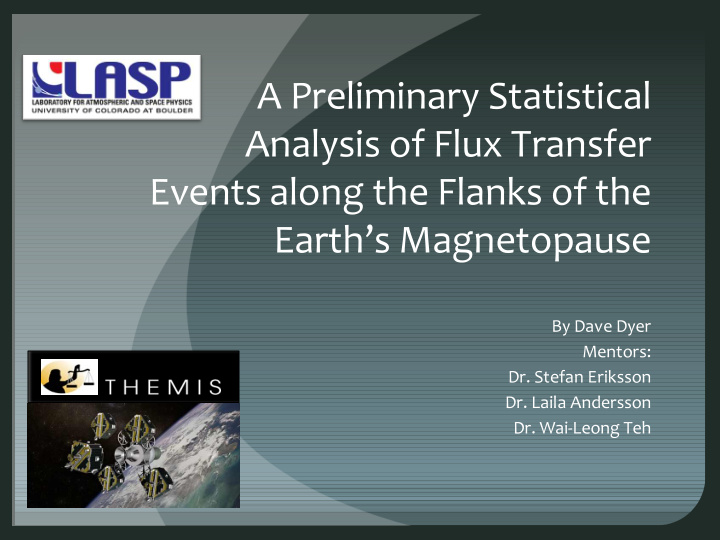



A Preliminary Statistical Analysis of Flux Transfer Events along the Flanks of the Earth’s Magnetopause By Dave Dyer Mentors: Dr. Stefan Eriksson Dr. Laila Andersson Dr. Wai-Leong Teh
Outline Motivation Background Methods Results Summary Acknowledgements Questions
Background 1: Definitions… FTE THEMIS Plasma Magnetosphere Magnetosphere Magnetosheath Magnetosheath Magnetopause Kelvin-Helmholtz wave and vortex
Background 2: Coordinate Systems…
Background 3: Plasma flow across THEMIS probes… Lower Energy Higher Flux Lower Flux Higher Energy Higher V Higher N Sun Lower V Lower N
Background 4: Magnetic field lines and bipolar events…
Background 5: What do the data look like? KH Surface Wave Flux Rope
Methods 1: Choosing probe survey dates…
Methods 2: Surveying ESA particle data for active KH dates… Yes! No!
Methods 3: The search for bipolar B N fluctuations…
Methods 4: MHD Reconstruction… Sonnerup & Teh, 2008
Results: Looking for patterns in FTE location… • Trailing-Edge FTEs dominate • No correlation between location and polarity
Results 2: Looking for polarity patterns… = +/- = -/+ • No dominant trend is readily apparent • Gap in data from -9 R E to -20 R E • Not enough data for conclusive results
Results 3: Looking for patterns with respect to distance down tail… Gap between -9 and -20 R E No significant patterns stand out for pressure, density, temperature or beta vs. distance down tail. Trailing Edge FTE Leading Edge FTE Internal FTE
Results 4: Still looking for patterns… Wide scatter for avg. | V| vs. dT (s) However, general trend toward larger FTEs farther down tail. <V N > is mostly negative. Trailing Edge FTE Leading Edge FTE Internal FTE
Summary Preliminary Analysis 11 dates out of 123 Missing data from -9 to -20 R E Still have probes A, D and E to survey Conclusive Results The non-result is a result Majority trailing-edge FTEs Mostly negative <V N > reinforces above result Possible Results Larger FTEs occur farther down tail Polarity may switch from mostly -/+ to mostly +/- farther down tail
Acknowledgments Thank you, Stefan, Laila, Wai-leong, Jianbao, Erin, Marty, Fran, Makenzie, and all of our REU summer school teachers. I learned more this summer than I ever anticipated and I greatly appreciate all of your help and guidance. Thanks to the NSF for funding this outstanding program, and all the LASP mentors for taking the time to participate. We know you are busy and appreciate your help. In addition, I would like to thank the academy, cheese sticks, pita chips, honeycrisp apples, facebook, passive-face, unicorns, rapping, star wars, legos, bianchi, Dr. Brown’s, the right-hand rule, Casa Bonita, Black Bart’s Revenge, clown cars, Steve Jobs (until he released the iPhone 4.0), Jebus, Gary Larson, and the infinite patience of the altruistic scientists and teachers who are willing to put up with the inquisitiveness of a 37 year-old would-be physicist.
References T. K. M. Nakamura, M. Fujimoto, and A. Otto, Structure of an MHD-scale Kelvin- Helmholtz vortex: Two-dimensional two-fluid simulations including finite electron inertial effects , JOURNAL OF GEOPHYSICAL RESEARCH, VOL. 113, A09204, 16 PP., 2008 doi:10.1029/2007JA012803 Bengt Sonnerup and W-L Teh, Reconstruction of two-dimensional coherent MHD structures in a space plasma: The theory , Journal of Geophysical Research, 113, A05202, doi:10.1029/2007JA012718, 2008 J. N. Glosli, D. F. Richards, K. J. Caspersen, R. E. Rudd,J. A. Gunnels, and F. H. Streitz, Extending stability beyond CPU millennium: a micron scale atomistic simulation of Kelvin-Helmholtz instability . SC '07 Proceedings of the 2007 ACM/IEEE conference on Supercomputing, pages 1-11, 2007. Taken from: http://www.aps.org/units/dfd/pressroom/gallery/richards.cfm http://www.brockmann-consult.de/CloudStructures/kelvin-helmholtz-instability- description.htm
Coordinate Systems Redux
Flux Rope Model
A more modern flux rope model
Recommend
More recommend